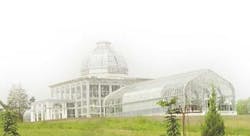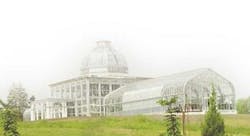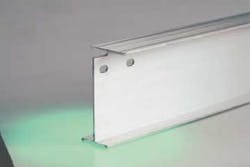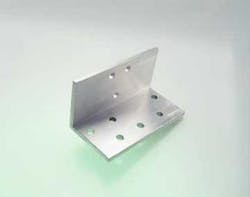Cutting Greenhouse Structures
Rough Brothers started maintaining and repairing wooden greenhouses in the Cincinnati area in the 1930s. Eventually, the company became a full-fledged manufacturer of wooden greenhouse structures. In the 1960s Rough Brothers switched its material from wood to metal-essentially steel and aluminum for the framework-and expanded its activities into the commercial and industrial markets, including larger-scale retailers, large commercial growers, schools, universities, and conservatories.
Although the company has a line of standard products, it also maintains a full engineering staff that designs custom work for clients. In such projects, the placement of holes, notches, and slots varies depending on the structure’s design.
Rough Brothers produces about 300 projects per year, ranging in value from $2000 to millions of dollars; its largest job, at $8 million, was the U.S. Botanic Gardens in Washington D.C. (pictured below). As one would imagine, thanks to such a workload the company processes a lot of steel tubing and aluminum extrusions. In fact, it handles about one million pounds of aluminum and from 2000 to 3000 tons of steel each year.
After receipt of a contract, company planners put together a cutting order, materials list, drawings, etc., for a job. The manual fabrication procedure, a seven- to nine-step process, involved bundling tubes for band sawing end cuts, then marking all the holes and notches and rebundling and moving the tubes to a punch press to produce holes near the ends. Then the tubes were moved to a drill press, which made holes in the middle of the tubes, as well as any necessary notches, and finally the tubes were sent for bending and welding as necessary. Because all metal is produced at one time for a given project, this led to a fairly expensive and time-consuming operation.
According to Rough Brothers President Richard Reilly, a little more than a year ago the company decided to look for a better and more flexible way to handle this production bottleneck. Laser cutting was the answer, and about a year ago the company purchased and installed a 4kW CO2 laser-powered Mazak (Schaumburg, IL; www.mazaklaser.com) Fabrigear 150. This system automatically loads, feeds, laser cuts, and unloads mill-length tube and structural material.
After a short startup and training period, Rough Brothers system operators began turning out laser-cut tubing, aluminum extrusions, and sheet metal components that exhibit tighter tolerances and straighter cuts than their manually produced counterparts. The resulting structures also went together with better fit-up and a dramatic reduction in component rework, plus a reduction in material handling. Now an order is processed in one cutting and drilling stop before it is welded, using a downloaded cutting program on the rotary laser.
Reilly says the laser cuts parts to a tighter tolerance compared to manual processes, and because dimensional accuracy is improved it is easier to put parts together for welding and assembly. This means field assembly time is reduced in the installation phase. The laser gives Rough Brothers the production flexibility it wanted and produces flexibility in design; a result it says is invaluable.
Reilly says the manual process was limited by tool design; certain slots required a special tool bit, which might not be available, delaying fabrication until it was delivered. Worse, he says, was that sometimes the bit didn’t exist, and the fabrication of the slot was impossible. With the laser, Rough Brothers can make any type of hole, slot, or notch, anywhere on the piece part. And the laser’s six-axis capabilities enable the company to make beveled or counter-sunk holes.
According to Reilly, it is an advantage to be able to design a slot without having to worry whether the tool exists. As long as it can be drawn on the computer it can be cut on the laser. This provides a different level of flexibility in terms of what can be done and how quickly it can happen. And because the response time is quicker, the company has been able to shorten its lead times. This is especially important in the fall, the company’s busy time, when customers want greenhouses installed before winter.
Reilly estimates the laser process has reduced fabrication time from 30 percent to 50 percent on average, and by as much as 80 percent on some projects. In his words, the laser cutting operation is more efficient than previous manual operations. Now, running two 10-hour shifts per day, six days per week (in the busy season), Reilly thinks he will get a return on his investment in 2 to 2 1/2 years. Considering that the company’s investment in this laser is two times greater than any investment it had made in any other equipment, this makes Reilly very happy.
Figure 1 shows a purlin, which is a 10- to 16-foot-tall post that runs from the ground to an A-frame truss that supports the roof of a typical greenhouse. It is made by cutting a series of holes, slots, and notches into an aluminum I-beam. On the rotary laser, Rough Brothers can produce one purlin in 10 minutes; it took 45 to 60 minutes to produce a purlin manually.
Another part, the aluminum angle connector seen in Figure 2, used to require three steps: first it was cut to length with a band saw, then each of its nine holes was laid off, and finally each hole was hand-drilled one at a time. Previously, it took Rough Brothers three hours to make 150 such parts. Now the laser produces 295 parts in the same time, a doubling of production.
Reilly admits that laser cutting aluminum can be a challenge because of the metals’ reflectivity to the 10.6 μm wavelength of the CO2 laser, and because each batch of aluminum is different. But the company has learned to readjust cutting conditions with each new batch.
Asked how he views the laser cutter, Reilly says, “For us, it was absolutely the right decision. We are very satisfied with the Fabrigear and the cut quality and tight tolerance that it produces.”



